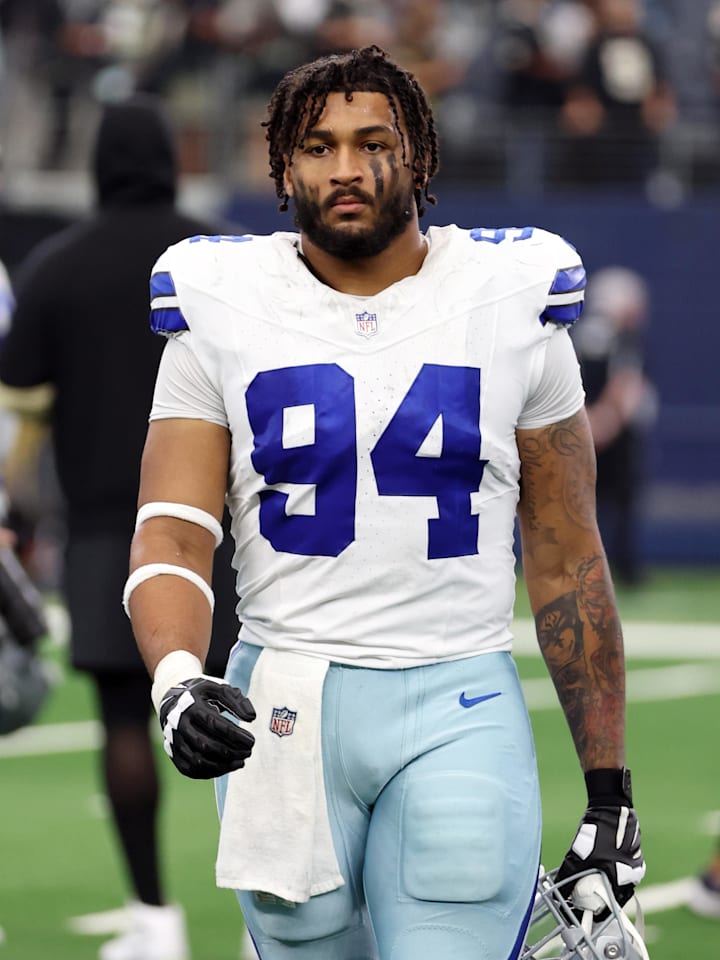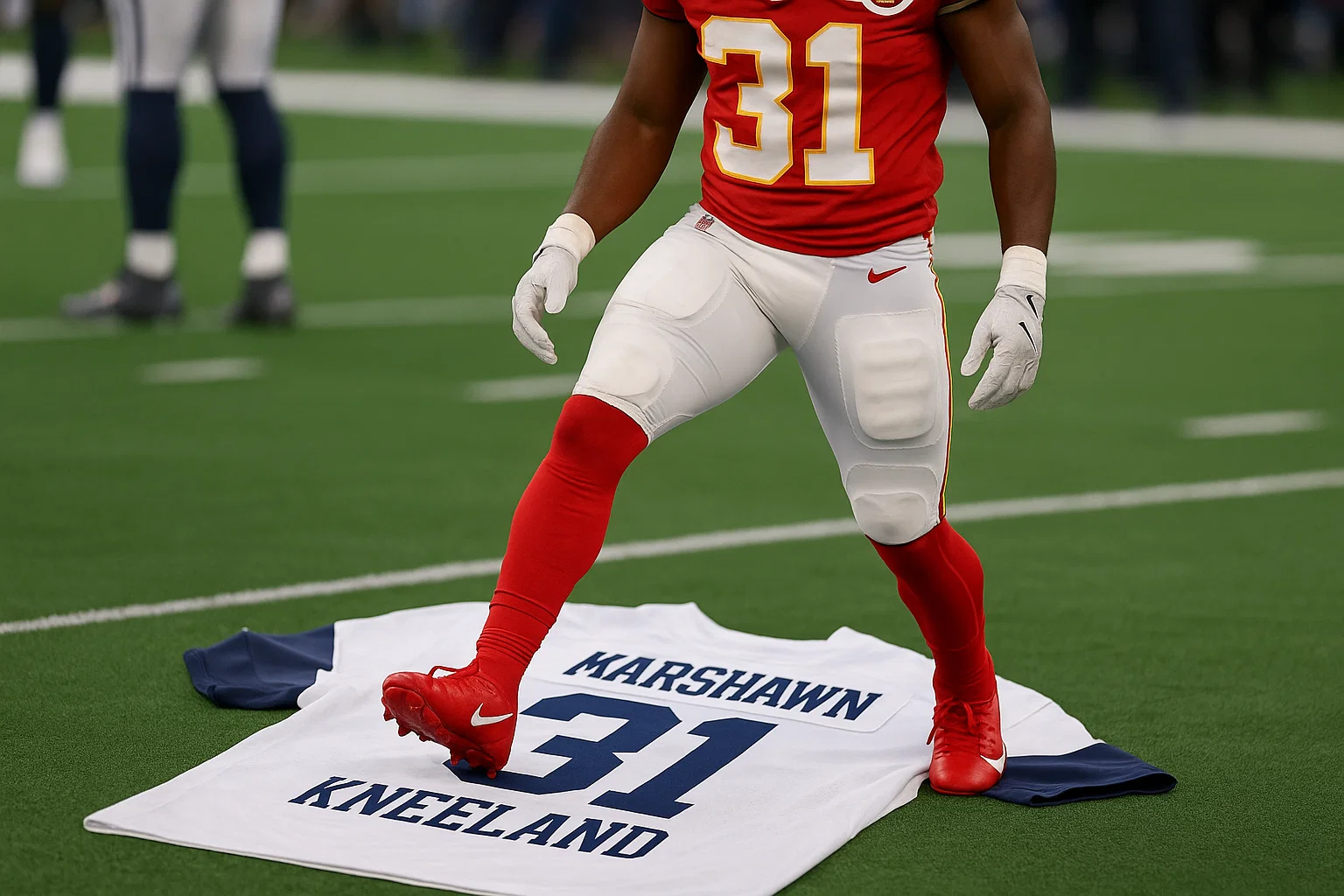SHOCKING NFL INCIDENT During yesterday’s game, a Kansas City Chiefs player was caught on camera stepping on the jersey of late Dallas Cowboys star Marshawn Kneeland. Fans and analysts are outraged, calling it disrespectful and unnecessary, especially given the tragedy surrounding Kneeland’s passing.-dithu2
SHOCKING NFL INCIDENT
In a shocking turn of events during yesterday's game, a Kansas City Chiefs player was caught on camera stepping on the jersey of the late Dallas Cowboys star, Marshawn Kneeland. This incident has left fans and analysts alike outraged, deeming the act as both disrespectful and unnecessary, especially in light of the tragedy surrounding Kneeland’s untimely passing.

The Incident Unfolds
The moment occurred during a pivotal part of the game, where tensions were already high. As the Chiefs player inadvertently stepped on Kneeland's jersey, which had been laid out in tribute, the scene quickly caught the attention of cameras and fans in the stadium and at home. Many were quick to share the footage on social media, with reactions pouring in almost immediately.
Outcry from Fans and Analysts
Reactions have been swift and vocal. Social media exploded with criticisms of the Chiefs player's actions. Fans expressed their outrage, emphasizing that disrespecting a player who contributed so much to the league is simply unacceptable. Comments ranged from expressions of disbelief to calls for accountability, with many stating that the incident highlights a troubling disregard for the legacy of former players.

One fan tweeted, "Stepping on someone's tribute jersey is disgraceful! Marshawn Kneeland deserves better from the league and its players." Analysts have joined in, discussing the broader implications of such a gesture, calling it indicative of a culture that sometimes overlooks the respect owed to the game’s history.
The League's Response
Amid the uproar, the NFL is reportedly conducting a review of the footage to determine the context and any potential consequences. This incident has amplified calls for the league to enforce stricter standards regarding player conduct, especially as it pertains to honoring the memories of those who have passed.
A league spokesperson stated, “We take matters of respect and sportsmanship seriously. We are reviewing the incident to ensure appropriate actions are taken.” Many fans are eager for a decisive response that reflects the organization’s commitment to honoring its players, both past and present.
Rekindling the Conversation

This incident has rekindled an essential conversation about respect within the NFL. Many are questioning the attitudes players carry onto the field—whether it’s toward their opponents, the game's history, or the fans. Commentators have noted that maintaining respect for players who came before them is crucial not only to honor their legacy but also to foster a culture of sportsmanship in the league.
Current players have been called upon to be role models in their behavior and attitudes, setting the tone for future athletes. The notion that actions reflect the values of the league is a topic that demands attention and serious reflection.
Conclusion

As the NFL continues its investigation, fans and analysts alike await the league’s response to this regrettable incident. There is a growing sentiment that the NFL must not only address the behavior of its players but also reaffirm its commitment to honoring the legacies of beloved figures like Marshawn Kneeland. The goal should be to establish an environment where respect is paramount, ensuring that such incidents are not just addressed but prevented.
The memory of Marshawn Kneeland deserves reverence, and as fans rally for change, they demonstrate their dedication to preserving the integrity of the game. The NFL stands at a crossroads, with an opportunity to lead by example and instill a culture that honors its history and the players who shaped it. 🏈✊
BREAKING: New York Giants Fire DC Shane Bowen Immediately After Crushing Loss to Lions - lunglinh

A Stunning, Midnight-Level Shake-Up That Signals Panic Inside the Giants Organization
The New York Giants didn’t wait until morning. They didn’t wait for meetings, evaluations, or the usual 48-hour cooling-off period after a humiliating defeat. Just moments after walking out of Ford Field following a crushing loss to the Detroit Lions — one that exposed every wound, every flaw, and every structural weakness in their defensive identity — the Giants made the kind of decision that franchises only make when trust evaporates and shockwaves are unavoidable. Defensive coordinator Shane Bowen has been fired, effective immediately.
The abruptness of the move stunned even veteran insiders. This wasn’t rumored, teased, or leaked throughout the week. There were no whispers about “hot seats” or “organizational frustration” coming to a boil. The decision dropped like a lightning bolt, a jarring acknowledgment that the Giants defense had reached a breaking point under Bowen’s leadership. And the timing — coming right after a nationally scrutinized humiliation at the hands of Detroit’s relentless offense — made it clear that the franchise didn’t just lose a game; they lost patience, belief, and confidence in the direction Bowen was steering them. This firing is the loudest admission yet that the Giants’ internal cracks have transformed into full-blown fractures.
The Loss That Forced the Giants’ Hand
Ford Field was a furnace from the opening kickoff, and the Lions brought the kind of physical, aggressive, high-tempo offense that tests the resolve of every defensive coordinator in the league. But what unfolded was beyond a mismatch. It was a meltdown — a systematic, repeated failure at every level of the Giants defense. Missed assignments. Broken coverages. Nonexistent pressure. Poor tackling. No adjustments. No sign of urgency despite the score slipping away drive by drive. Detroit carved through the Giants like they were running scrimmage reps, and by the time the fourth quarter arrived, the frustration on the Giants sideline wasn’t just visible — it was boiling over. Players slammed helmets.
Coaches barked at one another. The communication was chaotic, fragmented, and desperate. And the Lions, sensing disaster, kept pouring it on. Offense after offense, drive after drive, Detroit looked unstoppable — and New York looked unprepared, overwhelmed, and mentally broken. For ownership and the front office watching from above, the embarrassment wasn’t simply about the scoreboard. It was about watching a unit built on offseason investments and Bowen’s vision collapse under the brightest lights. The loss didn’t just hurt their playoff hopes — it erased trust in the man leading their defense.
Inside the Breakdown — How Bowen Lost the Locker Room
Sources close to the team have hinted for weeks that tension had been brewing between Bowen and several defensive veterans. While outwardly the staff projected unity, behind the scenes disagreements over scheme complexity, practice intensity, and communication had become increasingly difficult to contain. Bowen’s system demanded precision and discipline, but players increasingly felt the calls were confusing, rigid, and slow to adapt. The breakdowns on the field reflected a deeper fracture: the belief that Bowen wasn’t adjusting to the strengths of his personnel.
When you lose a locker room, you lose your defense — and in Detroit, the evidence of that loss was undeniable. Missed gap responsibilities. Safeties looking lost in coverage. Linebackers hesitating instead of attacking. Edge rushers unable to generate pressure because the scheme neutralized their instincts. The disconnect wasn’t just strategic — it was psychological. By halftime, players were out of sync with the calls, frustrated by the lack of halftime adjustments, and emotionally drained. When Detroit extended its lead in the second half, the Giants defense wasn’t fighting for pride. They were simply trying to survive. For ownership, that dynamic was a red flag too big to ignore. A defense that quits isn’t just poorly coached — it’s dangerously fractured.
Why the Firing Happened So Fast — and What It Says About the Giants’ Desperation
NFL teams rarely make immediate postgame staffing decisions, especially on the road. But this firing wasn’t symbolic — it was strategic. The Giants didn’t just lose a game; they lost control. And making a swift, aggressive move signaled two important things. First: ownership wanted to reassert authority. After watching their defense unravel, they needed to send a message that failure — especially failure rooted in misalignment and confusion — won’t be tolerated. Second: they needed to prevent a total locker room collapse. The defense already felt unstable, and another week under Bowen risked pushing the team into emotional freefall. Firing him immediately is the organizational equivalent of pulling an emergency brake. It’s chaotic, risky, and disruptive — but sometimes necessary when momentum spirals into disaster. The Giants know their season isn’t mathematically over, and they believe the only chance of salvaging competitiveness is to reset the defensive culture instantly. Whether that gamble works remains to be seen.
The Players’ Reaction — Quiet, Shocked, and Telling
Inside the locker room after the announcement, the atmosphere was thick with unease. Some players sat in stunned silence, others exchanged glances acknowledging the gravity of the moment. A few veterans privately admitted they saw this coming — not tonight, perhaps, but soon. Others were blindsided. No one cheered. No one complained. That silence spoke volumes. It wasn’t celebration, and it wasn’t resistance. It was the recognition that something had fundamentally shattered within the defense. Some players felt guilt. Others felt relief. But all understood this firing wasn’t about one game — it was about the accumulation of frustrations that reached a boiling point under national scrutiny. The quiet reaction wasn’t apathy. It was exhaustion. And exhaustion, for a football team, is often the final confirmation that a change had to be made.

What Happens Now — The Giants’ Path Forward Is Steep
Removing a defensive coordinator midseason is one thing; rebuilding identity on a short week is another. The interim coordinator will step in with the impossible task of stabilizing a defense that has been gashed, humiliated, and emotionally shaken. Simplifying calls will be the first priority. Rebuilding communication will be the second. Restoring aggression — real aggression, not schematic bluffing — will be the third. But the Giants also know this: firing Bowen doesn’t magically fix everything. The personnel still needs consistency. The locker room needs healing. The confidence needs rebuilding. And the schedule isn’t getting easier. This move is a rescue attempt, not a revolution. But sometimes a rescue attempt is all a struggling team has left.
A Franchise at a Crossroads — And the Fallout Has Just Begun
This firing is not the end of the story. It’s the beginning of a reckoning. The Giants front office will face questions about their offseason decisions, their midseason adjustments, and the internal dynamics that allowed this collapse to unfold. Coaches will be evaluated more aggressively. Players will be scrutinized. And the franchise as a whole will undergo the kind of pressure that often precedes sweeping changes. Bowen’s firing isn’t simply a reaction — it’s a symptom of something deeper. And unless the Giants address the root of that dysfunction, this won’t be the last shockwave. It will only be the first.





